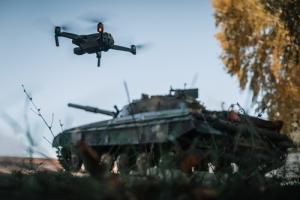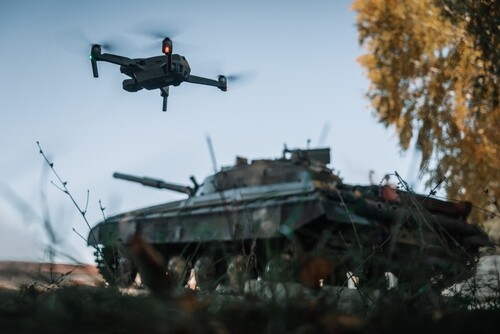Abstract: The current Russian campaign in Ukraine suggests that due to the ongoing Attrition Warfare, the Manoeuvrist Approach is becoming obsolete. Against this backdrop, the role of the operational level in accordance with military doctrine in terms of the general approach towards warfare is being examined. There is a focus on the linkage of these two approaches as well as their influence on and by selected operational principles. The central question concerns understanding the connections between these theoretical models and their implications for the operational level.
Problem statement: How are the theoretical models Manoeuvrist Approach and Attrition Warfare related, and what deductions can be made regarding understanding the operational level?
So what?: In the modern, complex operational environment, military leaders must be familiar with theoretical foundations and continually adapt and reassess them. Focusing on one doctrinal approach like the manoeuvrist approach because it is deemed as theoretical superior is wrong. Rather, the mutual support and interrelation of these doctrinal models must be understood in order to, following Clausewitz, impose one’s will on the enemy.

Source: shutterstock.com/Melnikov Dmitriy
Zeitenwende – Turning Point
With the incursion of Russian forces into Ukraine in the early hours of February 24, 2022, the European security landscape has been fundamentally altered. The security situation is now characterised as unstable and notably uncertain. In retrospect, with a focus on a military perspective, this trend could have latest been discerned as early as 2014. The annexation of Crimea marked the beginning of this transformation, and the resurgence of the conflict between Armenia and Azerbaijan in 2020 seamlessly fits into this narrative. Around 2022, the term Zeitenwende (i.e. turning point; change of times) was coined, precisely encapsulating this process under a single catchphrase. Zeitenwende was also chosen as the Word of the Year in 2022.[1] Originally attributed to German Chancellor Olaf Scholz, who used it in his speech three days after the Russian incursion,[2] the term has been used in the German-speaking realm since at least 2020 to describe this deteriorating security situation in the European context.[3]
From a military science perspective, these altered conditions, especially the political shift, must be comprehensively examined. Here, the theoretical model, according to Clausewitz, becomes apparent, in which the interdependencies between the people, politics, and military are elucidated and encapsulated within his wonderous trinity. On the political level, there has been a change in the will for national defence. For example, this among other things, is evident in the increased defence spending all over Europe[4] or an own defence industrial strategy by the EU.[5] Internationally, the enhanced focus on collective defence in Europe by the member states of the North Atlantic Treaty Organization (NATO) can also be cited as an example. At the NATO summit in Madrid in June 2022, the following goal was collectively established: “we underscore the need to significantly strengthen our deterrence and defence as the backbone of our Article 5 commitment to defend each other.“[6] The rationale behind this is inspired by NATO´s strategic concept of the Euro-Atlantic area not being peaceful.[7]
We underscore the need to significantly strengthen our deterrence and defence as the backbone of our Article 5 commitment to defend each other.
In Austria, the impacts of the Zeitenwende are currently observable in the military instrument of power. The defence capability of the Austrian Armed Forces is being restored through a comprehensive development plan known as the Aufbauplan 2032+. The necessary capabilities will be introduced gradually to meet the requirements for safeguarding the Republic of Austria.[8]
The author’s assessment suggests that there was significant public interest in the upheaval of security policy at the recent conflict’s outset. Daily media coverage provided updates on the developments of the war in Ukraine. However, apparently, general curiosity is waning. Nevertheless, the focal points surrounding Europe remain omnipresent in the media. Yet, the extent of active public engagement in the discourse cannot be conclusively derived. However, in this context, the military’s claim, or its task, is objective reporting and content mediation.
The specific research focus pertains to the role of the operational leadership level, examined in light of the current nature of warfare in Ukraine. The emphasis is on the alignment and interconnection of the two conceptual approaches, the Maneuverist Approach[9] and Attrition Warfare, as well as their influence by selected operational principles. The purpose is to enhance the operational readiness of military leaders by approaching the topic from an operational perspective. This aims to increase the understanding of military leaders regarding the function and tasks of the operational level, as the future operational environment is deemed complex and rapidly evolving.[10] Complexity necessitates simple guidelines that assist in task execution without constraining creativity, fully in line with the meaning of operational art. Consequently, it is intended to address the identified challenges in the Austrian Strategy Report 2024 to 2027 by analysing the character of current conflicts and supporting the achievement of the first objective.[11]
Direct and Indirect Approaches
The term attrition mostly refers to the trench warfare of the First World War, which, solely based on images, now bears remarkable similarities to the conduct of warfare in Ukraine. Characteristics of this approach are deep networks of entrenchment, the loss of mobility, as well as the concentrated use of artillery or, nowadays, tactical-level drones. However, from an operational level view, in defining the direct approach under which attrition falls, attention should not only be paid to the lack of mobility. Rather, it refers to the conceptual deployment of available resources, as illustrated by the following quote: “The direct approach entails deploying one’s own combat power directly against that of the opposing party. The aim is to diminish their combat effectiveness through continuous destruction of their elements of combat until, ultimately, one’s own will can be enforced.“[12]
The term attrition mostly refers to the trench warfare of the First World War, which, solely based on images, now bears remarkable similarities to the conduct of warfare in Ukraine.
Or, as NATO describes the direct approach: “Whereas an attritional approach seeks to achieve an incremental reduction of the hostile actor’s means and endurance, an annihilation approach demands the complete destruction of the actor’s means. These direct approaches can easily become stalemated, time-consuming and indecisive unless there is a significant advantage in combat power.”[13]
In contrast, the indirect approach (the Manoeuvrist Approach) can be described as follows: “The manoeuvrist approach provides the mindset required to achieve behaviour-centric outcomes by exploiting the inherent friction, uncertainty and human fallibilities found within competition. It represents an indirect approach that seeks to out-think and out-manoeuvre unsupportive or hostile actors (rivals, adversaries and enemies), and discourage stakeholders from becoming unsupportive or hostile actors); it focuses on degrading their will to contest.”[14]
Simply put, it can also be described as follows: “The objective here is to identify vulnerabilities within the opposing system and to deploy one’s own combat power predominantly against these vulnerabilities. Unlike the direct approach, the aim is to avoid engaging the elements of combat wherever possible.“[15]
From an operational level theoretical perspective, the indirect approach is preferable for achieving objectives as it utilises one’s own combat power more efficiently against the identified inherent weaknesses of the enemy. This is justified by the more judicious use of combat power, which is deemed critical for the success of an operation. It appears more efficient to strike at the vulnerabilities of the opposing party, although attrition can be equally effective. Moreover, the direct approach can be utilised to prepare for the indirect approach. This is exemplified by the combat actions around Avdiivka on April 25, 2024.[16], [17], [18], [19] After a long border stalemate, the Ukrainian defences were breached for a short amount of time. The question arises as to which conceptual model this example now belongs to.
The indirect approach is preferable for achieving objectives as it utilises one’s own combat power more efficiently against the identified inherent weaknesses of the enemy.
One possible explanation could be that, through the direct approach, a vulnerability was sought over an extended period. This could be loosely and somewhat abstractly termed “combat reconnaissance,” the search for a gap. On the other hand, the pursuit of the direct approach actually resulted in a critical vulnerability on the Ukrainian side, namely the available resources in the form of trained personnel and high-quality equipment. Thus, the manoeuvre was enforced through the direct approach.
From this definitional approach to the two conceptual models, two problem areas can be identified. Both problem areas address the planning and conduct of operations in a conflict with a similar character to the war in Ukraine. However, its adaptability, akin to the Clausewitzian chameleon,[20] is undisputed. This is also recognized in Austrian documents like the Landesverteidigungsbericht 2023,[21] alongside the increasing complexity: “key features of the future operational environment include complexity, uncertainty, as well as high agility and adaptability of the actors.”[22]
Principles, maxims, and fundamentals support tackling complex tasks. Thus, the following definition of an operational principle appears appropriate: “An operational principle is understood as a guideline that supports the definition, prioritization, and selection of actions and effects in fulfilling the mission of the higher echelon. An operational principle should serve as a conceptual aid for the planning and execution of operations, never to be considered as an axiom but rather shall seek to enhance creativity through holistic consideration.”[23] This self-definition appears necessary because neither NATO nor the US Army currently offers an up-to-date definition of the term operational principle that does not constrain the creativity of the leader or the staff. The US Army defines principles as cross-level fundamental guidelines that possess enduring validity and are thus immutable known as the Principles of War,[24] but they are formulated in a very broad and flexible manner and are, therefore, unsuitable as guidelines for a specific level. At the operational level, they are referred to as tenets and imperatives, some of which can be understood as evaluation criteria for the staff. NATO offers the Operational Planning Principles[25] and the Principles of Operations,[26] but also no definition per se.
The US Army defines principles as cross-level fundamental guidelines that possess enduring validity and are thus immutable known as the Principles of War, but they are formulated in a very broad and flexible manner.
These principles must always be considered in context, leading to the precise distinction of the two problem areas. The first problem outlines the effects of operational principles on the possibilities of the approach. Although all operational principles naturally play a role here, the principles of “Initiative” and “Maintain Combat Power” are crucial. The second problem addresses the principles’ vertical alignment within a national system. Here, too, the significance and necessity must be understood to fully harness the potential of these guidelines. In other words, the two problems could also be described as follows: The first deals with the internal view of the principles as standalone components that nevertheless significantly influence each other, while the second brings together these components and is therefore attributed to the external perspective, the holistic composite, the sum.
The Principles Initiative and Maintain Combat Power
The basis for this examination is the author’s master’s thesis, in which the operational principles of NATO and the U.S. military were compared and, after being reviewed in light of the character of the war in Ukraine, summarized, redefined, and adjusted.
The first principle is “Initiative,” which was defined as follows: Initiative in military operations means being proactive, adaptable, and maintaining momentum. It involves having clear goals, is partially promoted by flat leadership, and the ability to stay dynamic in complex situations. And also: “A resilient Centre of Gravity supports operational initiative and enables agility within the context of conflict dynamics.”[27]
The following graphic illustrates the connection of several principles with the principle of “Initiative”. The yellow boxes represent the underlying principles, while the purple line indicates the connection path to “Initiative”. It becomes evident that clear objectives are supported by vertical communication, predominantly facilitated by the principle of “Unity”. In the context of the Ukraine conflict, Russian objectives aimed at territorial acquisition and weakening the Ukrainian Armed Forces, while Ukraine aimed to repel the Russian attack and maintain territorial integrity.[28]
Additionally, the freedom to act is necessary to ensure flexibility. This flexibility allows the different branches of the military to support each other without jeopardizing unity. Clear objective definition promotes understanding and enables effective utilization of initiative. Ukraine demonstrated decentralized leadership, enabling units to quickly respond to changing situations. This fostered initiative by allowing troops to act locally and flexibly. However, this structure also revealed weaknesses in coordination at higher levels.[29], [30]
Clear objective definition promotes understanding and enables effective utilization of initiative.
Overall, it can be observed that clear objectives, freedom of action, and unity strengthen initiative. The Russian-Ukrainian war highlights the crucial nature of effective initiative, which can also present challenges, especially in a complex conflict environment.[31]
![The Relationship within the Principle Group of Initiative[32]](https://tdhj.org/wp-content/plugins/wp-fastest-cache-premium/pro/images/blank.gif)
The Relationship within the Principle Group of Initiative[32]
Essential to this principle is the recognition that it comprises several components. In NATO regulations, this principle is referred to as Maintenance of Morale,[34] but this is only one of the three aspects.[35] While the morale component is undoubtedly crucial for sustaining combat power, the author observes a focus on stability operations here. When sufficient trained personnel and equipment are available, the only variable is morale. However, the war in Ukraine demonstrates the importance of all three areas. At the onset of the conflict, the Russian forces struggled to maintain their combat power, leading to a loss of initiative. The Russian industry and logistics have since improved, strengthening the Russian side,[36] especially in the chosen attrition approach. Meanwhile, morale is high on the Ukrainian side, but logistical challenges are enormous, and the industrial base is limited, making the sustained maintenance of combat power difficult. Therefore, a crucial requirement for Ukraine is support in the form of military equipment from abroad.
![The Elements of Combat Power[37]](https://tdhj.org/wp-content/plugins/wp-fastest-cache-premium/pro/images/blank.gif)
The Elements of Combat Power[37]
The Vertical Alignment of Operational Principles
The operational principles cannot and should not stand alone but should be embedded in state action.
![The Alignment of the Operational Level Principles[38]](https://tdhj.org/wp-content/plugins/wp-fastest-cache-premium/pro/images/blank.gif)
The Alignment of the Operational Level Principles[38]
Furthermore, the vertical embedding of the principles is supported by theoretical models such as Clausewitz’s Trinity, supplemented by Herfried Münkler.[41] The assignment of the principles to the sides of the Trinity helps to understand the utility of the principles within a theoretical framework and to recognize their significance for the art of operational leadership.[42] Additionally, embedding the operational level into the military-strategic and strategic levels is depicted to illustrate how the operational principles are integrated into the overall state action. This embedding demonstrates how the various levels of military leadership collaborate to effectively deploy combat power and achieve the set objectives.[43]
The assignment of the principles to the sides of the Trinity helps to understand the utility of the principles within a theoretical framework and to recognize their significance for the art of operational leadership.
Supplementation instead of Exclusion
The connection between the conceptual frameworks of the Manoeuvrist Approach and Attrition Warfare is crucial for understanding the operational level in modern conflicts. While the indirect approach, the Manoeuvrist Approach, emphasises mobility, flexibility, and initiative, it should not be summarised under the term manoeuvre. This concept entails more than just movement. Rather, it aims to exploit the adversary’s vulnerability by efficiently using combat power to surprise and defeat them. On the other hand, Attrition Warfare, as a direct approach, aims to gradually wear down the enemy through continuous attacks on their combat power or just one of its three components. Similarly, the character of the war in Ukraine demonstrates that attrition could also indirectly lead to success.
In the context of the Russo-Ukrainian conflict, both concepts are evident in different phases of the conflict. Initially, the Russian forces employed the indirect approach. For instance, the unsuccessful storming of Kyiv,[44] along with all supporting actions (suppression of air defence, targeting command nodes) to neutralise the perceived Centres of Gravity, illustrates this approach. This led to a temporary disruption of the Ukrainian defence and a degree of surprise.
Initially, the Russian forces employed the indirect approach. The unsuccessful storming of Kyiv illustrates this approach.
However, the dynamics of the conflict changed over time as the Russian forces increasingly relied on the direct approach to deplete Ukrainian combat power. This represented a significant leveraging of strength (the availability of personnel and materiel) against a critical vulnerability of Ukraine (the availability of personnel and materiel). The use of artillery, drones, and other technological means played a crucial role in implementing this concept. This illustrates that both conceptual approaches at the operational level can work together and complement each other to disrupt the operational equilibrium. Above all, this analysis demonstrates that distinguishing between both approaches is not straightforward, but one parallel can be drawn between the offence and the defence. The offence seeks to achieve a decision. Defence merely serves to create the conditions for the offence. Similarly, one could reconcile the two conceptual frameworks—they complement each other.
This analysis of the operational level within the context of a methodological approach contributes to developing a comprehensive understanding of current and future conflicts. It demonstrates that military leaders can better comprehend their role in overall state action through theoretical, vertical alignment. Furthermore, it allows for creativity through holistic consideration, which is in line with the previously mentioned definition of operational principles.
Captain Johannes Ginthör is an attendee at the 23rd General Staff Training of the Austrian Armed Forces. He has research interests in military affairs, armed forces deployment, planning, and development. Additionally, he is currently engaged in a Master’s programme in “Military Leadership” at the National Defence Academy in Vienna. The views expressed in this article are those of the author and do not necessarily reflect those of the Austrian Armed Forces.
[1] Isabelle Daniel, “Gesellschaft Für Deutsche Sprache: “Zeitenwende” Ist Wort des Jahres,” Die Zeit, December 09, 2022, accessed April 25, 2024, https://www.zeit.de/kultur/2022-12/wort-des-jahres-2022.
[2] Olaf Scholz, “Reden zur Zeitenwende,” 1. Auflage (Bundesregierung Deutschland, Berlin, 2022), https://www.bundesregierung.de/resource/blob/992814/2131062/78d39dda6647d7f835bbe76713d30c31/bundeskanzler-olaf-scholz-reden-zur-zeitenwende-download-bpa-data.pdf.
[3] Tobias Bunde et al., “Zeitenwende Wendezeiten: Sonderausgabe des Munich Security Report zur deutschen Außen- und Sicherheitspolitik” (2020), https://securityconference.org/publikationen/msr-special-editions/germany-2020/, 11-12.
[4] European Defence Agency, “Record High European Defence Spending Boosted by Procurement of New Equipment,” last modified May 18, 2024, https://eda.europa.eu/news-and-events/news/2023/11/30/record-high-european-defence-spending-boosted-by-procurement-of-new-equipment.
[5] Sophia Besch, “Understanding the EU’s New Defense Industrial Strategy,” accessed May 18, 2024, https://carnegieendowment.org/posts/2024/03/understanding-the-eus-new-defense-industrial-strategy?lang=en.
[6] NATO, “NATO 2022 Strategic Concept: Adopted by Heads of State and Government at the NATO Summit in Madrid” (Online, 2022), https://www.nato.int/nato-welcome/index_de.html, 1.
[7] Ibid., 3.
[8] Österreichisches Bundesheer, “Militärstrategische Zielsetzung Und Zielbild “Österreichisches Bundesheer 2032,” accessed April 25, 2024, https://www.bundesheer.at/aktuelles/2024/zielbild-oebh2032.
[9] Brett A. Friedman, ON TACTICS: A Theory of Victory in Battle (S.l.: NAVAL INSTITUTE PRESS, 2020), https://search.ebscohost.com/login.aspx?direct=true&scope=site&db=nlebk&db=nlabk&AN=2665329, 17.
[10] Bundesministerium für Landesverteidigung, “Landesverteidigungsbericht 2023: gemäß Landesverteidigungs-Finanzierungsgesetz (LV-FinG)” (Wien, 2023), 13.
[11] Bundesregierung Republik Österreich, “Strategiebericht 2024 bis 2027,” 123.
[12] Johannes Ginthör, “Der russisch-ukrainische Krieg – Prüfstein des westlichen Verständnisses operativer Prinzipien?” (Masterthesis, Institut für höhere militärische Führung, Landesverteidigungsakademie, 2024), 26.
[13] NATO, “AJP-01: Allied Joint Doctrine” (Edition F Version 1, Online, 2022), 82.
[14] Ibid., 82.
[15] Johannes Ginthör, “Der russisch-ukrainische Krieg – Prüfstein des westlichen Verständnisses operativer Prinzipien?” (Masterthesis, Institut für höhere militärische Führung, Landesverteidigungsakademie, 2024), 26.
[16] Institute for the Study of War, “Institute for the Study of War,” accessed April 25, 2024, https://www.understandingwar.org/backgrounder/russian-offensive-campaign-assessment-april-24-2024.
[17] “War Mapper Auf X: „The Breach at Ocheretyne Widens as Russia Captures Most of the Settlement, Along with Novobakhmutivka and a Portion of Soloviove. Despite Ukrainian Reinforcements Arriving, They Have so Far Been Unable to Prevent Russia from Establishing a Foothold Around the Settlement. Https://t.Co/0rXoNnPABJ“ / X,” accessed April 25, 2024, https://twitter.com/War_Mapper/status/1783532670816776362?t=N3E7UZBEPhj0gcqOzjCVTQ&s=35.
[18] “OSINTdefender Auf X: „The Situation on the Southeastern Frontline of Ukraine Has Apparently Gone from Bad to Worse, with a Partial Collapse of Ukrainian Defensive Lines Reported to Have Occurred Overnight in the Donetsk Region After a Heavy Assault by Russian Mechanized Forces; During the Assault the“ / X,” accessed April 25, 2024, https://twitter.com/sentdefender/status/1783461773779050956?t=DsPOArb_bh-d5LKCZK1Upw&s=35.
[19] “MAKS 23 🇺🇦👀 Auf X: „😔 “The Leadership of the 115th Mechanized Infantry Brigade Is to Blame for the Failure of the Ocheretyno Defence, Allowing Significant Losses in Killed, Wounded and Missing”, – DeepState ❗️At the Same Time, Officer of the 59th Mechanized Brigade Serhiy Tsekhotsky Said That… Https://t.Co/2cRHF8nbqH“ / X,” accessed April 25, 2024, https://twitter.com/Maks_NAFO_FELLA/status/1783070728541155364?t=gOxRhPM4zoQ18tS_erLPww&s=35.
[20] Carl von Clausewitz, Vom Kriege: Vollständige letzte Fassung von 1832, [Vollständiger Nachdr. der Ausg. von 1832], RaBaKa pocket (Neuenkirchen: RaBaKa-Publ, 2010), 40.
[21] The Landesverteidigungsbericht 2023 is a white paper prepared as part of a reporting obligation to the Austrian Federal Government by the Austrian Armed Forces. It includes the status and future intentions regarding the planning and development of the Austrian Armed Forces.
[22] Bundesministerium für Landesverteidigung, “Landesverteidigungsbericht 2023: gemäß Landesverteidigungs-Finanzierungsgesetz (LV-FinG)” (Wien, 2023), 13.
[23] Johannes Ginthör, “Der russisch-ukrainische Krieg – Prüfstein des westlichen Verständnisses operativer Prinzipien?” (Masterthesis, Institut für höhere militärische Führung, Landesverteidigungsakademie, 2024), 25.
[24] Department of the Army, “Operations: FM 3-0” (US Department of the Army, Washington, DC, 2022), https://armypubs.army.mil/epubs/DR_pubs/DR_a/ARN36290-FM_3-0-000-WEB-2.pdf, 1–7.
[25] Supreme Headquarters Allied Powers Europe, “Comprehensive Operations Planning Directive” (Online, 2023), 1–10 – 1–11.
[26] NATO, “AJP-5: ALLIED JOINT DOCTRINE FOR THE PLANNING OF OPERATIONS” (2019), 2-1.
[27] Johannes Ginthör, “Der russisch-ukrainische Krieg – Prüfstein des westlichen Verständnisses operativer Prinzipien?” (Masterthesis, Institut für höhere militärische Führung, Landesverteidigungsakademie, 2024), 96-97.
[28] Ibid., 81–84.
[29] Ibid., 80–81.
[30] Ibid., 81–84.
[31] Ibid., 82–84.
[32] Ibid., 83.
[33] Ibid., 95.
[34] NATO, “AJP-3: ALLIED JOINT DOCTRINE FOR THE CONDUCT OF OPERATIONS” (2019), 1–12.
[35] Christian Schorn, “Die Joint Function Sustainment: Lehrveranstaltung Operatives Logistmanagement” (Lehrveranstaltung 9.4 des 23.Generalstabslehrganges, Wien, February 28, 2023).
[36] CEPR, “The Russian Economy on a War Footing: A New Reality Financed by Commodity Exports,” accessed May 25, 2024, https://cepr.org/voxeu/columns/russian-economy-war-footing-new-reality-financed-commodity-exports.
[37] Johannes Ginthör, “Der russisch-ukrainische Krieg – Prüfstein des westlichen Verständnisses operativer Prinzipien?” (Masterthesis, Institut für höhere militärische Führung, Landesverteidigungsakademie, 2024), 90.
[38] Ibid., 103.
[39] Ibid., 98–99.
[40] Ibid., 99.
[41] Herfried Münkler, “Clausewitz Und Die Neuen Kriege,” in Armis Et Litteris: Die Militärwissenschaftliche Schriftenreihe des Studienganges, ed. Insitut für Offiziersausbildung (2008), accessed February 24, 2024, 18:159.
[42] Johannes Ginthör, “Der russisch-ukrainische Krieg – Prüfstein des westlichen Verständnisses operativer Prinzipien?” (Masterthesis, Institut für höhere militärische Führung, Landesverteidigungsakademie, 2024), 100.
[43] Ibid., 101–103.
[44] Mykhaylo Zabrodskyi et al., “Preliminary Lessons in Conventional Warfighting from Russia’s Invasion of Ukraine: February–July 2022” (London, 2022), 29–36.





